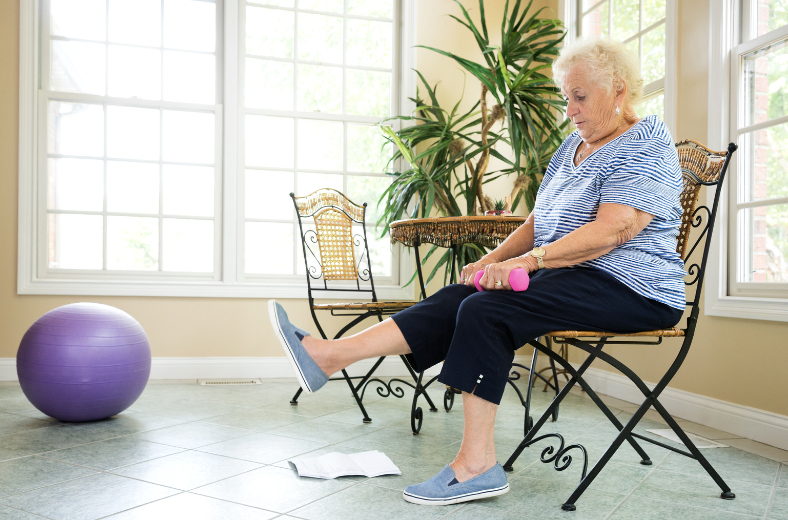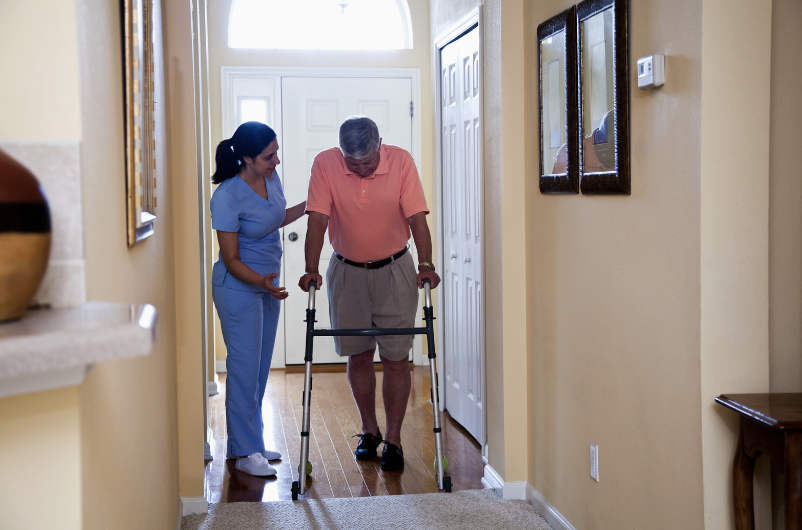Image by Natee Meepian's Images via Canva
Preparing for a Knee Replacement Surgery Part 1 discusses food and liquid restrictions and recommendations before a knee replacement surgery. This blog will discuss other factors and considerations when preparing for a knee replacement surgery.
Studies have shown that when people participate in their own care, knee replacement cancellation rates are reduced, and patient satisfaction with healthcare outcomes is improved. Cancellation rates of knee replacements can be reduced by involving the person in the scheduling of the surgery and pre-operation strategies. [1] This blog will further discuss these pre-operation strategies, and what you can do in the weeks and days leading up to your knee replacement.
Pre-operative characteristics such as pain and mental state impact the long-term results of a knee replacement surgery. [2] Exercise is a great way to reduce pre-operative pain for people awaiting knee replacement surgery. [2] Doing exercises before your knee replacement keeps your body and knee healthy. This is also known as prehabilitation. Prehabilitation is a set of exercises or physical therapy that is done before surgery. Prehabilitation has many benefits for long-term recovery after surgery. We have written a great blog about prehabilitation that includes a list of exercises that you can do as part of knee replacement prehab.

Image by wanderluster via Canva
There are also logistical things that can be done before your knee replacement. This includes preparing your home, scheduling your pre-operative appointment and packing for the hospital. [4]
Preparing your home
There are many assistive devices available to help you do certain activities like walking, getting dressed or using the restroom. This includes a walking aid (crutches, a cane or a walker), shoehorns and sock aids (a device that lets you slip socks on without bending over), grab bars around your home, grabber tools, a raised toilet seat and a tub chair. [5] We’ve written a great blog about how to use the bathroom and take a shower after a knee replacement here.
There are also many things you can do to prepare your home before your knee replacement surgery. This includes moving tripping hazards like rugs, electrical cords and general clutter. You’ll likely need a walker or crutches, so rearranging your furniture to create a clear walking path makes moving around easier. You may also have trouble bending down after surgery, so placing things you regularly need within reach keeps you from bending down or reaching up high. [5]

Image by kali9 via Canva
Schedule your Pre-Operative Appointment
About one week before your surgery, your doctor will make sure you are physically and mentally ready for surgery. During your pre-op appointment, you’ll be checked for any symptoms of an underlying condition or illness such as hypertension, a cardiovascular condition or respiratory concern. They’ll also talk to you about your medical history. Then a nurse will go over what to expect during your surgery and after. You should also check with your doctor to see if you need to adjust your medications. Some medications can interfere with your recovery and you may need to stop taking them for a certain amount of time before surgery. [5] This includes blood thinners, over-the-counter nonsteroidal anti-inflammatory drugs (NSAIDs) such as naproxen (Aleve), ibuprofen (Advil, Motrin) and aspirin because they make it more difficult for blood to clot, which can increase blood loss during surgery. [4] Some types of antidepressants and medicines that help with neurological conditions can also interfere with anesthesia. You should also talk to your doctor about vitamins or supplements you’re taking. They’ll let you know if it’s safe to use those leading up to surgery. [5]
Packing for the Hospital
If you have a walker or crutches, bring them to the hospital. If you don't, the hospital may provide them before you're sent home. You should also pack dental care items, deodorant and other toiletries. You should also pack comfortable and loose-fitting clothes, slip-on shoes, identification and your cell phone. [4]
Multidisciplinary Pre-Operative Approach
Research has also proposed a multidisciplinary pre-operative approach to address patient characteristics before a knee replacement. [2] This includes psychological factors and social factors, because they can impact the outcomes of a knee replacement surgery. Having poor pre-operative psychological health has been reported to reduce function and increase pain levels up to 3 years after a knee replacement [2]. Reduced stay in the hospital after surgery also makes preparing people before surgery even more important for post-operative rehabilitation [3]. Typically, preoperative psychological and educational programs are administered by nurses or psychologists. These interventions include learning about the procedure and potential feelings or sensations that you may experince, coping strategies, relaxation techniques and how to seek support. [3] Information about the surgery has the most widespread benefits in postoperative recovery. [3] Psychological interventions include reducing feelings of anxiety and increasing your sense of control. Strategies include cognitive restructuring (re-interpreting your sensations), calming self-talk and mental relaxation techniques.
Conclusion
Pre-operative characteristics such as pain and mental state impact the long-term results of a knee replacement surgery, so exercising, engaging in preoperative psychological and educational programs, and more logistical things such as preparing your home, attending your preoperative appointment and packing your hospital bag will not only makes things easier after your surgery, but it will also reduce the likelihood of a cancelled surgery and improve your satisfaction after your surgery. For more information about preparing for a knee replacement surgery, specifically food and liquid restrictions, check out part 1.
Want to learn more about knee replacements? Try the Curovate app, an evidence-based app that will provide you with a physical therapy plan, guided video exercises and ways to measure your range of motion and monitor your rehabilitation progress! Download Curovate today by clicking the links below.
 |
 |
|---|
Other recommended blogs
- Can I Kneel After a Knee Replacement?
- What is the Recovery Timeline for a Total Knee Replacement?
- How Can I Relieve Pain After my Total Knee Replacement?
References
1. Caesar, U., Hansson-Olofsson, E., Karlsson, J., Olsson, L. E., & Lidén, E. (2022). A sense of being rejected: Patients’ lived experiences of cancelled knee or hip replacement surgery. Scandinavian Journal of Caring Sciences, 36(4), 1054-1063.
4. UCSF Health. (n.d.). Preparing for Knee Replacement Surgery. University of California San Francisco.
5. Johnson, P. (n.d.). How to prepare for a knee replacement. HealthPartners.







